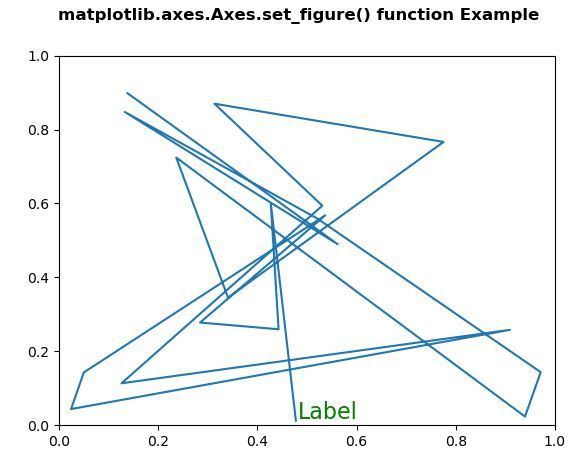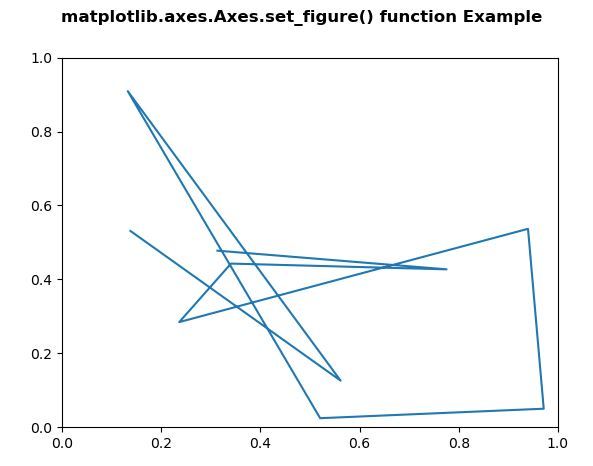Matplotlib es una biblioteca en Python y es una extensión matemática numérica para la biblioteca NumPy. La clase Axes contiene la mayoría de los elementos de la figura: Axis, Tick, Line2D, Text, Polygon, etc., y establece el sistema de coordenadas. Y las instancias de Axes admiten devoluciones de llamada a través de un atributo de devoluciones de llamada.
Función matplotlib.axes.Axes.set_figure()
La función Axes.set_figure() en el módulo de ejes de la biblioteca matplotlib se usa para establecer la figura para estos ejes.
Sintaxis: Axes.set_figure(self, fig)
Parámetros: este método acepta solo un parámetro.
- fig : este parámetro es la instancia de la figura.
Devoluciones: este método no devuelve ningún valor.
Los siguientes ejemplos ilustran la función matplotlib.axes.Axes.set_figure() en matplotlib.axes:
Ejemplo 1:
# Implementation of matplotlib function
import numpy as np
import matplotlib.pyplot as plt
import matplotlib.lines as lines
import matplotlib.transforms as mtransforms
import matplotlib.text as mtext
class GFGfun(lines.Line2D):
def __init__(self, *args, **kwargs):
self.text = mtext.Text(0, 0, '')
lines.Line2D.__init__(self, *args, **kwargs)
self.text.set_text(self.get_label())
def set_figure(self, figure):
self.text.set_figure(figure)
lines.Line2D.set_figure(self, figure)
def set_axes(self, axes):
self.text.set_axes(axes)
lines.Line2D.set_axes(self, axes)
def set_transform(self, transform):
# 2 pixel offset
texttrans = transform + mtransforms.Affine2D().translate(2, 2)
self.text.set_transform(texttrans)
lines.Line2D.set_transform(self, transform)
def set_data(self, x, y):
if len(x):
self.text.set_position((x[-1], y[-1]))
lines.Line2D.set_data(self, x, y)
def draw(self, renderer):
lines.Line2D.draw(self, renderer)
self.text.draw(renderer)
np.random.seed(10**7)
fig, ax = plt.subplots()
x, y = np.random.rand(2, 20)
line = GFGfun(x, y, mfc ='green',
ms = 12,
label ='Label')
line.text.set_color('green')
line.text.set_fontsize(16)
ax.add_line(line)
fig.suptitle('matplotlib.axes.Axes.set_figure() \
function Example\n\n', fontweight ="bold")
plt.show()
Producción:
Ejemplo 2:
# Implementation of matplotlib function
import numpy as np
import matplotlib.pyplot as plt
import matplotlib.lines as lines
import matplotlib.transforms as mtransforms
import matplotlib.text as mtext
class GFGfun(lines.Line2D):
def __init__(self, *args, **kwargs):
self.text = mtext.Text(0, 0, '')
lines.Line2D.__init__(self, *args, **kwargs)
self.text.set_text(self.get_label())
def set_figure(self, figure):
self.text.set_figure(figure)
lines.Line2D.set_figure(self, figure)
np.random.seed(10**7)
fig, ax = plt.subplots()
x, y = np.random.rand(2, 10)
line = GFGfun(x, y, mfc ='green',
ms = 12,
label ='Label')
line.text.set_color('green')
line.text.set_fontsize(16)
ax.add_line(line)
fig.suptitle('matplotlib.axes.Axes.set_figure() \
function Example\n\n', fontweight ="bold")
plt.show()
Producción:
Publicación traducida automáticamente
Artículo escrito por SHUBHAMSINGH10 y traducido por Barcelona Geeks. The original can be accessed here. Licence: CCBY-SA